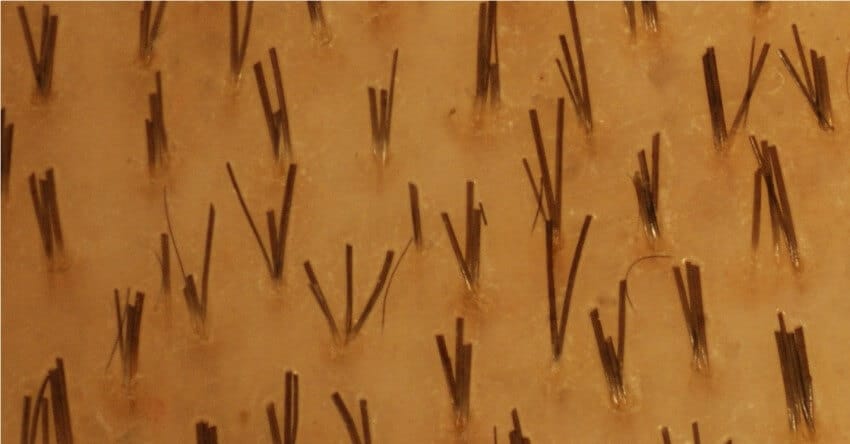Follicular Unit Transplantation

Learn everything you need to know about the Follicular Unit Transplantation (FUT) hair transplant technique.
Written by Dr. Konstantinos Anastassakis, MD, PhD.
First published in February 2016, new content May 2021
Is the FUT hair transplant technique “outdated”?
No, it isn’t. And whenever you come across such a claim, be very cautious — what you’re reading is not a scientific article but an advertisement!
On the contrary, the Follicular Unit Transplantation (FUT) technique is the most comprehensive, thorough, and scientifically documented method of Hair Transplantation.
This position also reflects the official stance of the ISHRS — the International Society of Hair Restoration Surgery.

A mega-session case with more than 4,000 hair follicles. The result photos are taken 12 months after the FUT Hair Transplant procedure.
There is no “old” or “new” hair transplant technique; surgical techniques are always the result of the evolution of previous methods, whose “roots” can even be traced back to ancient times, especially when we talk about General Surgery techniques.
The FUT hair transplant technique is an evolution of the strip method, first introduced in 1963. Meanwhile, the FUE technique, often presented as the “new” hair transplant method, is actually an evolution of the Punch Graft technique that appeared in 1959.
Therefore, it can be argued that the FUT hair transplant technique has more “recent” roots in the Science of Surgery.
However, this is not what matters, because surgical techniques are not like laptops or TVs, where the newest is always the best or most advanced!
What truly matters is the result it can provide for the patient.
As we will see below, the results of the FUT hair transplant technique are unparalleled.
Even in the donor area, which many patients worry about regarding scarring, the modern FUT hair transplant technique applied at Anastasakis Hair Clinic leaves a scar as fine as the natural hairs in the donor area.
No scar after any surgical procedure is 100% invisible. However, as you can see from the results of our transplants, using our experience and techniques, it is extremely difficult to detect scars in the vast majority of our patients.
The Modern Follicular Unit Transplantation (FUT) Technique
The results achieved with FUT Hair Transplantation have made hair transplant procedures very popular since the technique first appeared in 1993. As the outcomes became increasingly natural and dense, public perception shifted away from the unnatural results of “prehistoric” hair transplant methods, such as punch grafts, scalp flaps, and scalp reductions.
A specialized surgeon and a large, experienced surgical team can, in a single session using the modern FUT Hair Transplant, provide such impressive density and 100% natural-looking results that no one would realize a hair transplant has been performed—or that the patient once experienced hair loss.
Thanks to continuous micro-improvements enabled by science and technology, results with the Follicular Unit Transplantation (FUT) technique are now excellent, indistinguishable from natural hair in both density and appearance.
Performing a high-standard FUT hair transplant procedure is no longer something a surgeon with only basic interest in hair restoration can do. It requires a large, trained surgical team and investment of tens of thousands of euros in surgical equipment. As a result, FUT hair transplantation today is limited to a few dedicated surgical teams with high expertise and outstanding outcomes.
These surgical mega-teams, using the modern FUT technique, can perform mega-sessions with 3,500–4,000 follicular units in a single day, optimizing the donor area to the fullest (with zero graft loss and minimal trauma) and achieving coverage identical to the patient’s hair before hair loss began.
What does Follicular Unit Transplantation mean?
The translation of the term Follicular Unit Transplantation is “Transplantation of Follicular Units.”
The principle of the FUT technique is the preservation of the natural, intact, independent follicular unit (FU) and the transplantation of only natural follicular units.
The FUT hair transplant may represent the culmination of the evolution of hair transplant procedures regarding the recipient area, specifically:
- The natural appearance of the final result
- The perfect imitation of normal hair growth
- Maximum graft survival
- Minimal trauma
- Optimal density.
What is a follicular unit (FU)?
The anatomist Headington discovered in 1984 that hair follicles on the human scalp do not grow one by one but in groups, forming Follicular Units (FUs) that contain 1–5 hair follicles, share a common sebaceous gland, common sensory nerves and blood vessels, all enclosed in a single connective tissue “sheath.” From the bulb (root) to the epidermis, the hair follicles within each follicular unit resemble an upside-down bouquet of flowers, with the bulbs oriented randomly in the subcutaneous tissue and the hairs converging as they emerge at the skin surface. The average number of hairs per follicular unit is 2.2, but there are individuals with an average of 1.3 hairs per follicular unit (unsuitable candidates for hair transplantation) up to individuals with an average of 3.0 hairs per follicular unit (ideal candidates for hair transplantation). The discovery that hair grows naturally in follicular units led to the understanding that each follicular unit is an independent micro-organ!
The most important aspect of the FUT hair transplant technique, which revolutionized the surgical treatment of hair loss, is the discovery that when we transplant each micro-organ as a whole (without splitting it into smaller follicular fragments) and independently (without transplanting it in the same site as other micro-organs), the result is:
- Maximum survival of the follicular units
- Maximum coverage of the thinning or bald area
- Minimal trauma to the recipient area
- Perfect imitation of the natural appearance of the hair
- Absolute patient satisfaction from the dense and natural result!
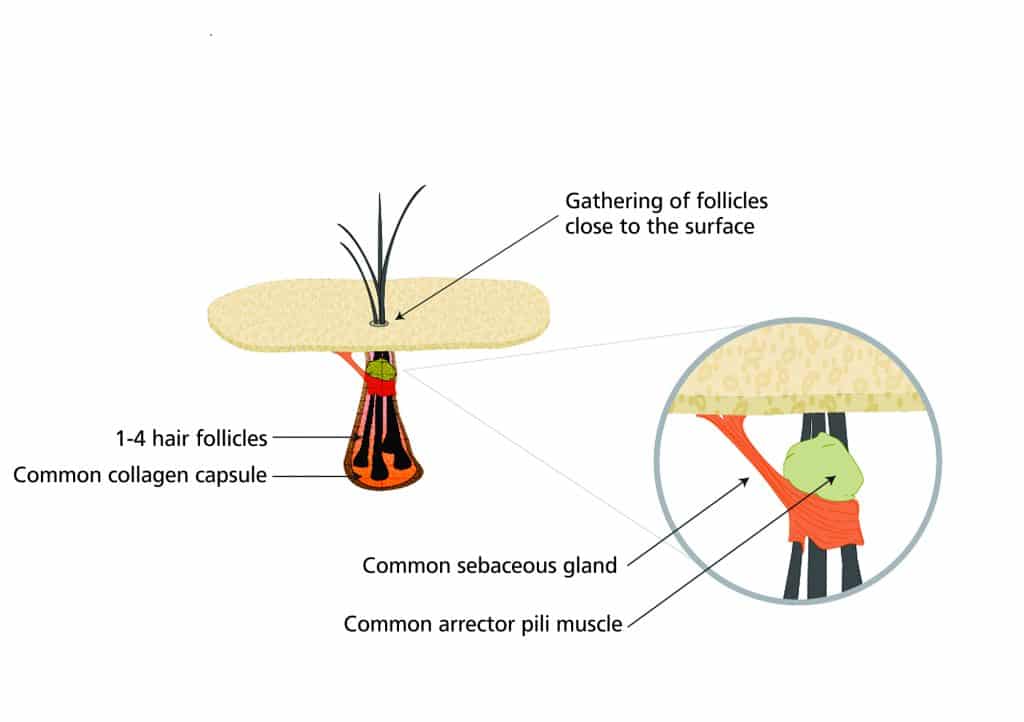
Representation of the microscopic view of a natural follicular unit as an independent micro-organ
Trichoscopy image showing clearly that almost all follicular units contain more than one hair, which converge at the surface like small bouquets of flowers.
What is the difference between FUT and FUE hair transplantation?
From the removal of the follicular units onwards, the remaining steps are the same for both techniques. However, the FUT hair transplant technique excels in the most important aspects of hair transplantation overall, because it offers:
- FUT grafts are the gold standard in hair transplantation, but under certain conditions and with excellent technique, FUE grafts can be comparable.
- Larger sessions, meaning that in a single session we can transplant more follicular units and provide greater coverage. With the FUT technique, a specialized surgeon with an experienced team can transplant 3,500–4,000 follicular units per day, or more than 5,000 in two consecutive days (asymmetric FUT technique). In contrast, with the FUE technique, the same surgeon can transplant 1,200–2,000 follicular units in one day, or up to 4,000 follicular units in 2–3 days.
- Minimal trauma and minimal scarring in the donor area. The total area of scar tissue after FUT is 4 to 12 times smaller than that caused by FUE for the same number of grafts! (See here, F5-2016)
- All follicular units we transplant are permanent and will never fall out again. Conversely, if it is necessary to remove more than 4,000 follicular units over a person’s lifetime using only FUE, follicular units must be taken from outside the safe permanent hair zone. This area is the central section, 2–3 cm wide, in the posterior and lateral scalp. The follicles that are necessarily removed from outside this zone—i.e., above or below the safe permanent hair zone—are not guaranteed to be permanent! These follicles are very likely to fall out in the future from the recipient area because they are not permanent follicles.
- It can be applied to every hair type, even curly or white hair. On the other hand, the FUE technique has certain limitations for specific hair types due to follicle morphology. If the surgeon is not very experienced, extraction is very difficult and often there are significant losses due to graft trauma.
-
There is no need to shave the donor area; on the contrary, existing hair covers the closure of the donor area.
What is the most important advantage of the FUT hair transplant technique?
The most important advantage is that with the FUT hair transplant technique, you can be sure that the person performing your surgery is a surgeon, and moreover, an experienced surgeon. This is because the FUT technique involves specific surgical steps that only an experienced surgeon can perform. The extraction of the follicular units in a continuous strip is done with a surgical incision, while the subsequent suturing is performed with a special two-layer hairline closure that only a specialized and experienced surgeon knows how to execute.
The FUT hair transplant technique requires many years of general surgical experience, knowledge, and composure, and in particular, experience in handling the scalp, which is the area with the most blood vessels in the human body.
Thus, with the FUT technique, you can feel more secure knowing that the person performing your hair transplant is an experienced medical surgeon.
In contrast, in many “clinics,” in order to reduce costs and attract clients, the FUE hair transplant technique is performed by untrained staff or even non-physicians. There is a misleading perception that FUE is not a surgical procedure and is a technique that anyone can easily learn. Of course, this does not mean it can be performed correctly. That is why the ISHRS sought to correct this misunderstanding by changing the term in FUE from Extraction to Excision.
Additionally, a surgeon with only basic interest in hair transplantation will not be able to perform a FUT hair transplant procedure to high standards, as it would require staffing, training, and maintaining a large team of surgical nurses and investing tens of thousands of euros in surgical equipment. FUT hair transplantation is now limited to a few dedicated surgical teams with a high level of expertise and excellent results.
Personally, as a specialized and certified Scalp Restoration Surgeon, I consider this safety—that the procedure is necessarily performed by a physician, and moreover, an experienced one—to be the greatest advantage of the FUT hair transplant technique.
What are the disadvantages of the FUT hair transplant technique?
However, let’s look at them more closely:
- With careful surgical technique, using FUT, the donor area heals leaving an almost imperceptible scar, just 0.5–1 mm wide (half to one millimeter!) that can be easily covered by hair just 5–6 mm long. When the surgeon is specialized and certified as a Scalp Restoration Surgeon, the resulting scar is always minimal and unnoticeable, even with short hair of 5–6 mm.
- The same hair length is required to cover the thousands of micro-scars from the FUE technique, i.e., 5–6 mm, the same as a typical FUT scar. There is a perception that those who do FUE can cut their hair shorter than 5–6 mm or even shave it! This is not true because on a shaved scalp or with hair shorter than 5–6 mm, the micro-scars are visible as small white dots at the points where the follicular units were collected.
- Finally, the period of abstaining from intense activities is really significant only for professional athletes or workers in heavy manual jobs (laborers, movers, gym instructors). Anyone else can abstain from heavy exercise for 1–2 months, meaning from weightlifting, bodybuilding, and martial arts. Everything else is allowed!
Personally, as a specialized and certified Scalp Restoration Surgeon, I consider these disadvantages to be very minor compared to the advantages of the FUT hair transplant technique.
What happens with the large scars I have seen in some people with shaved heads?
No one undergoes a hair transplant with the purpose of shaving their head afterward; they do it to have hair and enjoy it. Therefore, whenever you see a man with a shaved head and one or more scars at the back of the scalp, he is someone who should never have undergone a hair transplant, either because he was not a suitable candidate from the start or because his doctor did not perform the procedure correctly. Someone who, despite having had a hair transplant, ends up shaving his head, this happened for one reason: the result of the hair transplant was so unnatural, sparse, or even nonexistent that he prefers the donor area scar to be visible rather than have hair even one centimeter long that would hide the scar!
In reality, these people with scars and shaved heads either were never suitable candidates for a hair transplant (and therefore should never have been operated on!) or their doctor was careless and not specialized in hair transplantation.
These poor hair transplant results in unsuitable patients or by unqualified surgeons are unfortunate but fortunately can be corrected with modern FUT, FUE, and BHT hair transplant techniques.
Personally, as a specialized and certified Scalp Restoration Surgeon, I can guarantee that at Anastasakis Hair Clinic, with the FUT hair transplant technique, it will never again cross your mind to shave your head, because you will be completely satisfied with your appearance and will enjoy your hair at any length you desire!
How is a hair transplant performed with the FUT technique?
The FUT hair transplant involves collecting follicular units from the donor area (at the back or sides of the scalp) in a single strip. Specifically, we take the follicular units intact, not one by one, from the safe donor zone of permanent hair, and then restore the incision with a continuous two-layer hairline closure.
In the safe donor zone of permanent hair, the follicles are genetically programmed to continue growing throughout the individual’s life, without ever being affected by the androgens that initially caused hair loss. This property remains permanent, wherever we transplant them!
We remove these follicular units and reposition them in the bald or thinning areas of the scalp.
In the FUT hair transplant technique, the follicular units are not divided into smaller grafts, nor are multiple follicular units combined into larger grafts. The FUT technique ensures maximum survival of the follicular units and a completely natural appearance, so they are indistinguishable from natural hair.
Additionally, the follicular units themselves are at least 50% smaller than the older minigrafts, allowing us to place them closer together, achieving densities that were previously unimaginable, or even placing them among existing hair to increase density.
In their new position, the transplanted follicular units grow for the individual’s entire lifetime, never falling out, producing normal hair that grows, can be combed, cut, dyed, and will gray just like the rest of the hair.
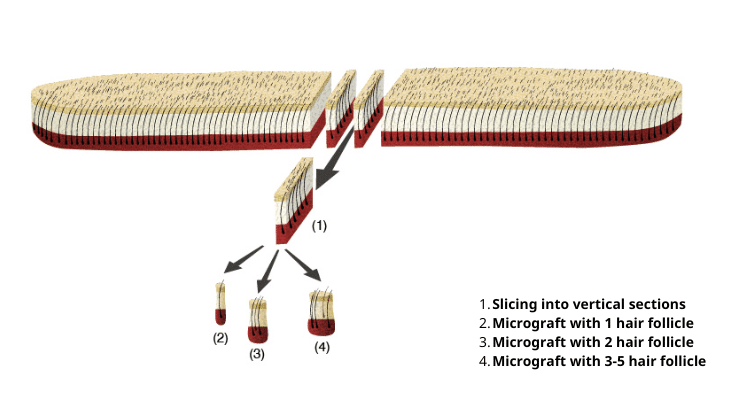
With older techniques, the follicular units were divided into grafts with fewer hairs or combined into larger minigrafts with high volume, which appeared unnatural and sparse.
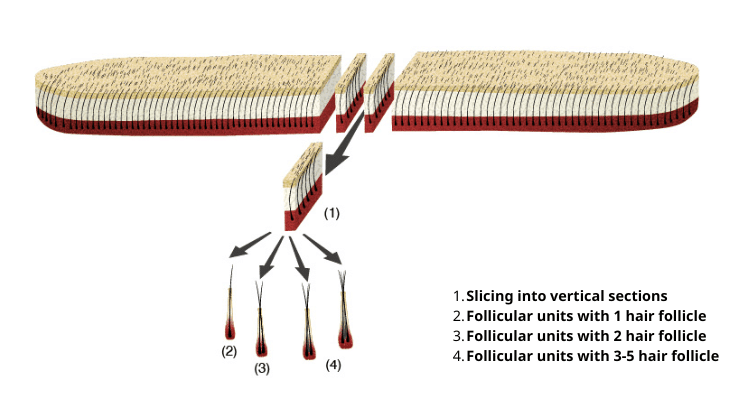
In modern hair transplantation using the FUT technique, intact follicular units with minimal volume are transplanted, allowing them to be placed very close to each other for maximum density and naturalness.
Regarding the front hairline, where the hair begins on the forehead, the placement technique of the grafts precisely replicates the natural appearance of a normal hairline.
Only natural single-hair follicular units are placed in the hairline, irregularly, without following a specific pattern (i.e., the follicular units are not placed in a straight line next to each other) but following the direction and angle of natural hair growth, for a fully natural appearance.
The result of the hair transplant is hair that behaves just like your original hair and is indistinguishable, no matter how closely it is examined.

Only single-hair follicular units are transplanted in the hairline, placed irregularly without following a specific pattern, providing complete naturalness. The angle, direction, and orientation of the hairs are exactly the same as they were before, and the transplanted hair is indistinguishable.
Technical details of the FUT hair transplant technique
It is important to know that from the day of the procedure, it takes approximately 4 months for your new hair to start appearing, and thereafter it continues to grow at a normal rate (usually 1 cm/month). Therefore, at least 8 months are required after the procedure before a significant amount of hair is visible. In fact, your new hair continues to mature in color, mass, and texture up to 18 months after the procedure.
The process of harvesting and placing the grafts with the FUT technique is as follows:
-
- Under local anesthesia in the donor area at the back of the scalp, the follicular units are harvested intact from the safe permanent donor zone and the incision is then closed using a two-layer hairline closure with continuous sutures. The follicular units we collect are genetically programmed to grow for the rest of your life and will never fall out.
- The hairline closure is the method used to close the donor area in all our FUT cases. Specifically, a two-layer hairline closure with plastic suturing is performed. This special technique allows hair to grow through the scar, making it virtually invisible.



With the hairline suturing technique, already on the day the sutures are removed from the donor area (10th–12th day), the scar is virtually invisible. The red marks are the points where the suture held. In the future, hair just 5–6 mm long will be enough to cover a well-closed FUT incision.
- The area where the hairline closure has been performed is covered by the surrounding hair, as there is no need to shave the donor area. The donor area heals within 10–14 days, and the remaining scar is difficult or even impossible to detect among your permanent hair, even if your hair is only about 5–6 mm long.
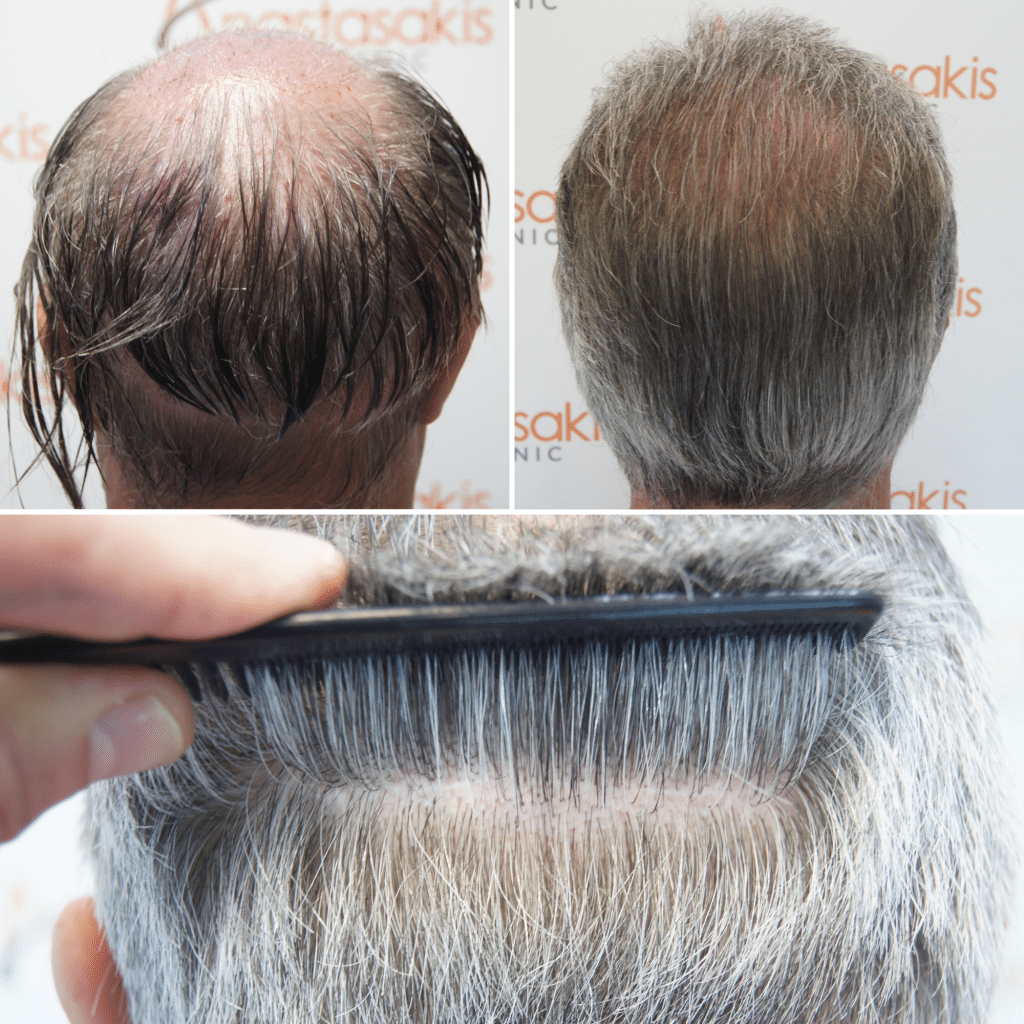
Image of the donor area immediately after the procedure and 12 months after the procedure. - The single strip of follicular tissue is converted into individual follicular units through a sterile, two-step microscopic dissection process.Using Mantis Vision stereo-microscopes, follicular units are isolated in their natural form — meaning they are not divided (even if they contain 3, 4, or 5 hairs), nor are two or more follicular units combined into a larger “multi-graft.”Each graft — each follicular unit — measures no more than 1 mm in width

Follicular units are prepared using specialized stereo-microscopes and categorized according to the number of hairs they contain — ranging from 1 to 5 hairs. Depending on the number of hairs, each follicular unit is strategically placed in different areas of the recipient zone to optimize both natural appearance and density 
Image of follicular units prior to placement in the recipient area: Follicular units are prepared in such a way that they retain adequate tissue at the base, protecting them from desiccation and mechanical trauma during implantation. At the same time, they are refined at the top, allowing them to be placed with very high density - By using stereo-microscopes at every stage of the procedure, up to 30% more follicular units can be identified and successfully transplanted compared to older methods — thanks to the minimized risk of damage and zero graft loss
- Once local anesthesia is applied to the recipient area, reception sites are created using sapphire micro-blades (0.8–1.0 mm wide) or custom-made micro-blades (0.7–0.9 mm wide), precisely tailored to receive each individual follicular unit.

Depending on the size of the follicular unit, a different tool is used to create the corresponding recipient site. The general rule is to use the smallest possible instrument suitable for each follicular unit size, in order to minimize trauma.An 18G needle has a diameter of 1.1 mm. A 19G needle has a diameter of 0.9 mm. A 21G needle has a diameter of only 0.7 mm. Alternatively, sapphire micro-blades are used, ranging from 0.8 to 1.0 mm wide, depending on the size of each follicular unit. 
Recipient area after the creation of the incisions. The incisions have been temporarily stained with methylene blue to make them easier to identify.Notice that in the first and second frontal hairlines, the incisions are smaller and denser, designed to receive single-hair follicular units. Just behind those, the incisions are slightly larger (for two-hair follicular units), and further back, they become even larger and more widely spaced, to accommodate multi-hair follicular units. 


In every part of the recipient area, the surgeon must adjust the density, direction, angle, and orientation of the incisions to ensure absolute naturalness - The incisions are designed to replicate the density, angle, direction, and orientation of the original hair in that area, making the transplanted hairs indistinguishable from natural hair, even at close inspection
- Follicular units are placed one by one into the tiny recipient sites using either fine forceps or a blunt implanter, which helps to minimize manipulation and trauma


Each follicular unit is implanted using either specialized forceps or implanters. The choice of technique and instruments depends on the surgeon’s preference, and neither method is superior in terms of the final result. What truly matters is the careful handling of the delicate grafts, ensuring they are not compressed or unnecessarily stressed. - The follicular units are placed with absolute precision into the recipient area — especially in thinning zones — in a way that avoids damaging existing follicles and perfectly matches the original hair’s growth characteristics. Depending on the number of hairs per follicle, each unit is placed in a different region, closely following natural growth patterns. Single-hair follicular units are reserved for the frontal hairline or center of the crown, as they offer the highest naturalness and provide a soft transition into denser areas.
- When the patient leaves the clinic and goes home, no gauze or bandage is needed to cover any part of the scalp. The follicular units remain securely in place, healing naturally, without leaving any visible trace.
- An FUT hair transplant procedure typically lasts 4 to 9 hours, depending on the number of grafts being transplanted.A small FUT session may involve 1,000–1,200 follicular units.A Mega-session may reach or exceed 3,500–4,000 follicular units.



Mega-session case using the FUT technique with over 3,500 follicular units. Shown: Before the FUT hair transplant, immediately after the procedure, and 12 months later – final result - The scar is barely visible, thanks to the trichophytic closure, which allows hair to grow through the scar line.
As a result, once healing is complete and over time, the scar becomes undetectable among the surrounding hair, even when the hair is as short as half a centimeter.

Typical scars of the FUT hair transplantation technique on days 10–12 at Anastasakis Hair Clinic. Over the following 12 months, each of these microscopic scars will thin by 40–50% due to healing and will acquire a white color, identical to the surrounding skin.
- The single strip of follicular tissue is converted into individual follicular units through a sterile, two-step microscopic dissection process.Using Mantis Vision stereo-microscopes, follicular units are isolated in their natural form — meaning they are not divided (even if they contain 3, 4, or 5 hairs), nor are two or more follicular units combined into a larger “multi-graft.”Each graft — each follicular unit — measures no more than 1 mm in width
Summary
In FUT Hair Transplantation, the surgeon carefully designs and extracts the necessary number of follicular units from the back of the scalp in a single strip, while ensuring a minimal or nearly invisible scar. The trichophytic closure technique allows the incision to heal tightly with little to no visible marking.
Unlike the outdated minigrafts and micrografts, FUT grafts are not cut to size; they are separated based on their natural form as they exist in the scalp — as independent follicular units.With the use of high-powered stereo microscopes, which allow us to see exactly where the hair grows beneath the skin, the natural follicular units are isolated with minimal surrounding tissue, preserving the integrity of each graft.FUT transplantation minimizes trauma and scarring in the recipient area, optimizes graft survival and healing, and achieves a perfectly natural arrangement, angle, and direction of growth. Sessions with over 3,500 follicular units in a single day are entirely feasible.
To achieve these ideal results, the technical demands on the surgeon and especially the assistant team are significant. Success requires teamwork, professionalism, and an advanced level of expertise — something only a few surgical teams can truly offer.A well-trained and experienced FUT surgical team can achieve graft survival rates as high as 98%.Very few surgeons are fully trained and committed to performing all FUT stages with precision.
Instead, many clinics resort to using grafts of varying sizes or hybrid techniques to speed up the procedure — often at the cost of naturalness and graft survival. The two scientifically accepted methods for hair transplantation are FUT and FUE. Their main difference lies in how the grafts are harvested. The choice of method should always be based on the individual needs of the patient. At Anastasakis Hair Clinic, we are able to deliver full and natural results, often using a combination of both techniques to achieve the best possible outcome. We focus on personalized care tailored to each patient’s goals and hair characteristics, aiming for maximum satisfaction.
If you would like to learn more about the cost of hair transplantation, our clinic offers a completely free assessment — easy and convenient, from the comfort of your home. Simply send us photos, along with some basic information and your goals, via our free consultation form, and you’ll receive a full evaluation — usually within 3 business days, with no obligation whatsoever.



